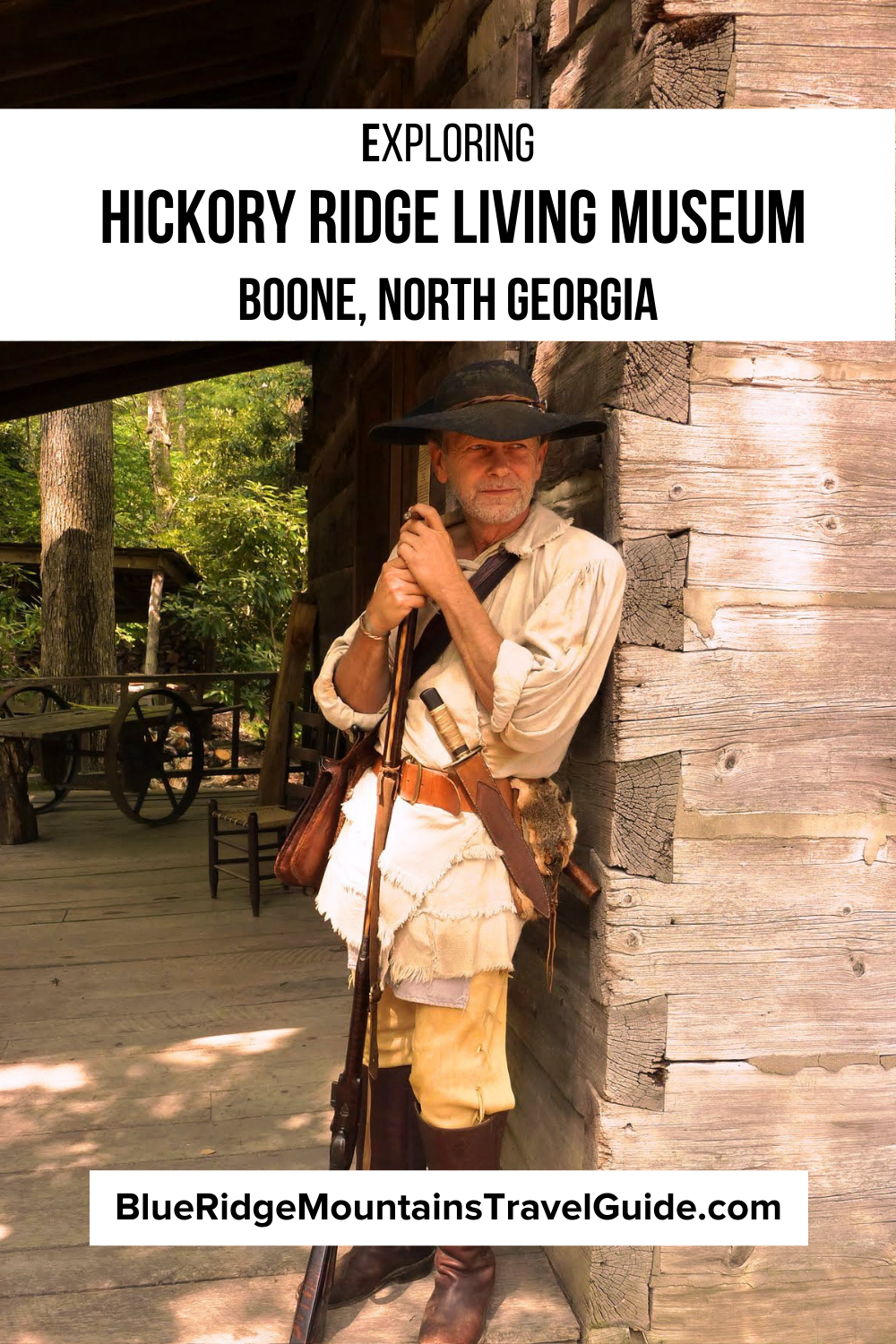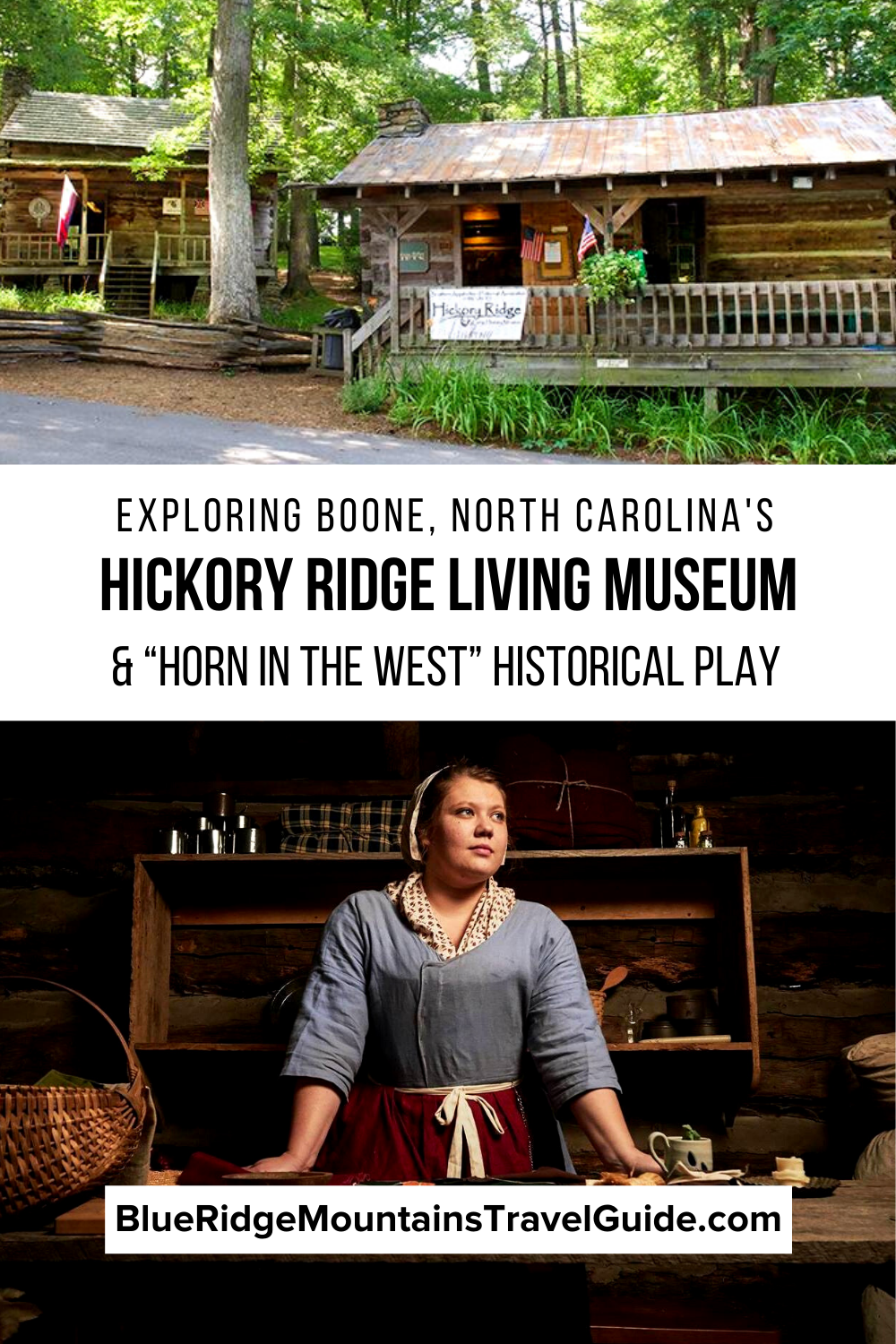The Southern Appalachian Historical Association was formed to preserve the history and cultural heritage of Watauga County and the surrounding areas in the North Carolina mountains.
It does this in a variety of ways– through theatrical performances, educational programs, and an excellent living history museum.
Located in Boone, the seat of Watauga County, the Hickory Ridge Living History Museum focuses on life in the NC High Country.
It primarily centers on the Colonial era between 1785 and 1805, exploring the skills that allowed early settlers of these remote mountains to be self-sufficient despite the harsh winter climate.
The museum is home to numerous artifacts from the period, including six historic Blue Ridge cabins.
It also features “Horn in the West,” an entertaining and enlightening historical play about the early settlers of what is now known as the mountain town of Boone NC.
Here’s a look at what the museum and play can teach visitors about what life was like in this small mountain community right around the time the United States was winning its independence…
READ MORE: The Appalachian Culture & History of the Blue Ridge Mountains

Hickory Ridge Living Museum Info
ADDRESS: 591 Horn in the West Dr, Boone NC 28607
PHONE NUMBER: 828-264-2120
WEBSITE: https://www.horninthewest.com/
HOURS: April-Nov, 10am-4pm (Tues-Fri), last tour leaving at 3pm, 10am-2pm (Sat)
ADMISSION: $8 for adults, $5 for children 5-12, special events $10 adults/$7 children
“Horn in the West” Info
LOCATION: Daniel Boone Park
SHOWTIMES: Tues-Sun 8 pm, gates open at 7:30 (during the summer)
CONTACT: 828-264-2120 or [email protected]
READ MORE: The 15 Best Things to Do in Bryson City NC & Swain County

Quick Facts
• The town of Boone is named after famed U.S. frontiersman Daniel Boone. He was not a resident of the community, but he grew up in the Yadkin Valley, near present-day Mocksville NC.
He’s said to have frequently camped in the area where Boone is now located. Thanks to the 1960s TV series about him, Daniel Boone is most recognized for wearing a coonskin cap, which he did not actually do.
Though he was a fur trader, Boone didn’t like fur hats. He was more partial to a wide-brim felt hat.
• The play “Horn in the West” was written by Dr. Kermit Hunter, who penned over 40 historical dramas.
He was also a talented musician, having attended the Julliard School of Music, and also managed the North Carolina Symphony. He received two graduate degrees from UNC Chapel Hill.
• The six historic Hickory Ridge cabins date from the late 18th century to the early 1900s, and they were all originally erected in the NC High Country.
These buildings have each been retroactively altered to accurately represent specific functions, such as a working blacksmith shop and tavern.
READ MORE: 30 Fascinating Blue Ridge Mountains Facts

Directions to the Hickory Ridge Museum
Daniel Boone Park and the Hickory Ridge History Museum are both located in the heart of Boone NC.
Horn in the West Drive is right off US-321, which runs through the middle of town.
The parking area is for both museum visitors and the outdoor performance of “Horn in the West.”
Directions from Blowing Rock
Visitors from Blowing Rock can reach the museum in less than 15 minutes. Just hop on US-321 N, and it’ll take you all the way to Boone.
Turn right on Deerfield Road, left onto State Farm Road, right on US-221, and finally left on Horn Avenue.
Horn in the West Drive will be on the right.
Directions from Asheville
Heading east on the I-40 from Asheville, take exit 72 onto US-70, moving north towards Old Fort. Turn left onto NC-80N, right onto Toms Creek Rd, and left onto US-221N.
Technically, US-221N will take you all the way to Boone. However, there is a section past Linville known as the Little Parkway Scenic Byway, which is 18 miles of curviness that makes the Blue Ridge Parkway blush.
To avoid the delay of driving the byway, drivers can take the NC-105/US-221 Truck. The US-221 Truck intersects the US-321 Truck route, which goes into downtown Boone.
The trip takes about two hours, making for a great day trip from Downtown Asheville.
READ MORE: 15 Best Things to Do in Boone NC (Blue Ridge Parkway MM 291.8)

Southern Appalachian Historical Association History
SAHA, a non-profit organization, was founded in 1951 to operate an annual production of Kermit Hunter’s outdoor drama, “Horn in the West.”
The organization is focused on preserving the cultural heritage of the High Country region, with particular attention placed on Daniel Boone and the American War for Independence.
Daniel Boone Park is a 36.5-acre property purchased by the Town of Boone in 1957 from James B. and Carrie W. Winkler to provide recreation, education, and historical preservation for local residents and visitors alike.
The park’s Horn in the West Drive now has several noteworthy attractions.
These include the Daniel Boone Amphitheater, where the play is performed; Daniel Boone Native Gardens, a project of the Garden Club of North Carolina; and the Hickory Ridge Museum.
Since its inception in 1980, Hickory Ridge History Museum has furthered SAHA’s effort by providing guests with a glimpse into the day-to-day lives of colonialists in Western North Carolina.
READ MORE: The 15 Best Things to Do in Cherokee NC & the Qualla Boundary

The “Horn in the West” Story
SAHA’s production of “Horn in the West” is celebrated as the longest-running Revolutionary War drama in the United States.
The outdoor drama is the story of British Dr. Geoffrey Stuart, his wife Martha, and their son Jack coming to the Colony of Carolina so that the doctor can study smallpox.
When Dr. Stuart finds himself a respected leader in the small community, he must battle between his loyalty to the British Crown and his regard for the Regulators’ desire for independence.
The play dramatizes life as it was for the resilient settlers of the Blue Ridge Mountains, including Daniel Boone. It depicts the hardships, dangers, and ties that the small mountain communities of the time would have had.
This play ran every year consecutively from 1952 through 2019, pausing for the COVID-19 pandemic in 2020. It is set to reopen for its 69th season in June of 2021.
READ MORE: 40 Fascinating Facts About The Blue Ridge Parkway

Exploring Hickory Ridge Living History Museum
The Hickory Ridge Living History Museum is composed of six historical cabins, some of which date back to the late 1700s. They have all been re-imagined to correctly represent buildings of that time.
The cabins are the backbone of the museum. Rather than one central building housing a host of artifacts, each building has its own thematic representation of what a home, tavern, blacksmith shop, and hunter’s cabin would have looked like at the time.
Though none of the Hickory Ridge cabins were from this exact site, each log cabin is from the area around Watauga County and has been adapted to represent a functional building from this era. All of them were donated to SAHA by local families.
The Tatum Cabin, which is meant to capture what Daniel Boone’s cabin might have looked like, dates all the back to 1785.
The Coffey Cabin was built in 1875 in Aho NC, and was the home of Thomas and Ellen Coffey and their 10 children.
Frazier Cabin is from the mid-1800s, and was originally erected in Watauga County before being moved to Caldwell County (and ultimately back).
Each cabin is filled with historical artifacts of the time period. Many of these artifacts are reproductions, but there are some that are actually 200+ years old!
READ MORE: Top 10 NC State Parks in the North Carolina Mountains

The Historical Interpreters
Beyond the historical items found in the cabins (and the cabins themselves), the living history museum is staffed by “interpreters.”
Each of them wears period clothing and performs tasks that were customary of the Colonial era.
These guides demonstrate skills such as hearthside food preparation, blacksmithing, hand-sewing, and yarn spinning using antique tools of the trade.
These living history interpreters really help to resurrect the atmosphere of remote mountain settlements during the American Revolutionary War.
Tours & Special Events
Tours of the museum are offered every Tuesday through Saturday from early April to mid-November. The tours take about 30-45 minutes and are led by historical interpreters.
Throughout the season, there are also several special events hosted by the Hickory Ridge Living History Museum.
These events include militia battles, craft demonstrations, Daniel Boone Day, and an American Independence Day celebration. –by Jonathon Engels; all photos courtesy of the Hickory Ridge Living History Museum
READ MORE: The Best Western NC Christmas Tree Farms in Boone, Asheville, & Beyond




